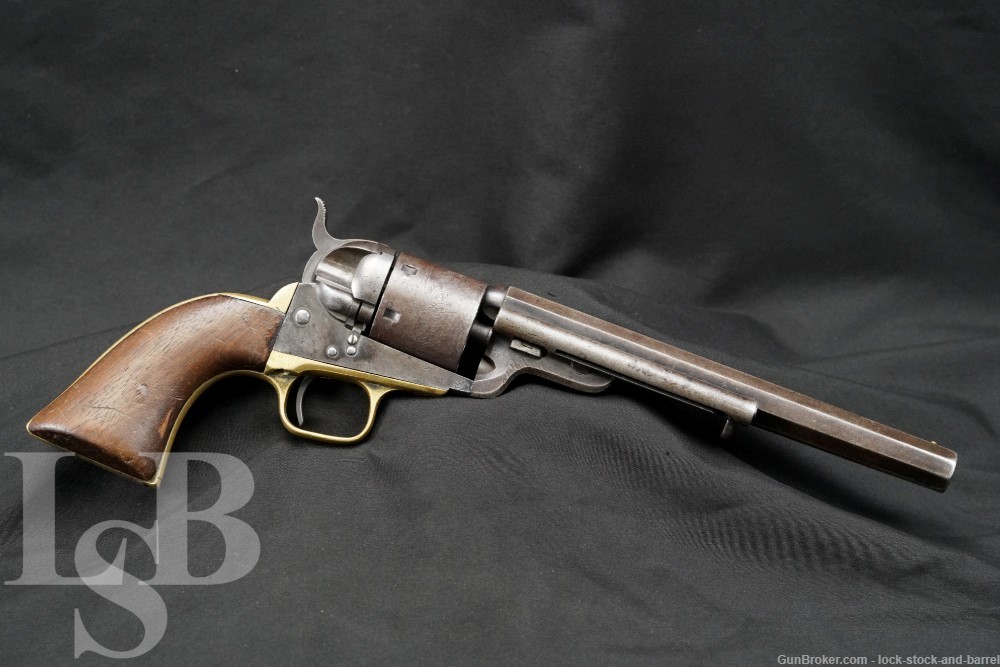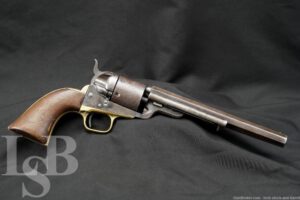
Colt 1851 Navy Richards-Mason .38 CF Centerfire Conversion Revolver Antique
SOLD FOR: $3130
LSB#: 230324AJ031
Make: Colt
Model: 1851 Navy, Richards-Mason Conversion
Serial Number: 9760
Year of Manufacture: Ca. 1872
Caliber: .38 Centerfire
Action Type: Single Action Side-Loading Gate Cartridge Conversion Revolver
Barrel Length: 7 1/2”
Sights / Optics: The front sight is a brass post fixed to the barrel. The rear sight is a “V”-notch in the nose of the hammer, visible when cocked.
Stock Configuration & Condition: The grip is one-piece smooth walnut. There are small losses at the bottom-front corner on each side. There are some scattered nicks, scuffs and scratches with a more notable ding on the right side toward the bottom-front. Some areas show thinning finish. There are no cracks. Overall, the grip is in Very Good-plus condition as Antique.
Type of Finish: Blue, Case Color and Silver Plated Brass
Finish Originality: Original to factory conversion.
Bore Condition: The grooves are mostly bright, the lands are gray. There is scattered erosion and pitting, mostly on the lands. The rifling is strong. In this writer’s opinion, the bore rates about 6 out of 10.
Most antique firearms have bores that will show erosion. This is not only due to age but to the use of black powder. When fired, black powder reacts corrosively. NRA Antique Firearm Conditions Standards are quite lenient for bores. In some cases the NRA standards disregarded the bore’s condition for collectors firearms.
Overall Condition: This pistol retains about 10% of its metal finish. Finish remains only in protected areas and around some raised features. Most exposed surfaces have gone to a light patina with edges worn to white. There are some scattered nicks, scuffs and scratches. Most notable are nicks around the wedge, on the barrel lug, and on the butt. Each chamber has a small shelf on the outside edge near the mouth of the chamber, appearing to be a manufacturing defect. The screw heads range from sharp to tool marked with usable slots. The markings range from clear to worn and incomplete. Overall, this revolver is in about Very Good condition as Antique.
Mechanics: The action functions correctly. The cylinder locks up with little play on each chamber. The barrel has no play to the frame. The trigger is crisp. We did not fire this pistol. As with all used firearms, a thorough cleaning may be necessary to meet your maintenance standards.
Box, Paperwork & Accessories: None.
Our Assessment: The latter half of the 19th century saw incredible developments in firearms technology, as various types of self-contained cartridge arms and repeating arms were invented. Some manufacturers and gunsmiths took advantage of the large supply of percussion revolvers, converting them to use cartridges. Colt’s was no exception, with their most notable conversion types being the Thuer, Richards and Richards-Mason conversions. The Richards-Mason conversion involved plugging the channel for the loading rod assembly, blending it with the barrel assembly, installing an ejector assembly on the right of the barrel and installing a plate on the recoil shield which housed the loading gate assembly as well as taking up the space of the nipple portion of the cylinder which was not needed for use with cartridges. A firing pin was then added to the hammer, either on the side for rimfires or in the middle for center-fire conversions such as this one.
This example is either a Model 1851 Navy which has gone through a Richards-Mason conversion or a factory cartridge gun produced with 1851 Navy parts still in inventory at Colt’s in the early 1870s. The serial number would be too early for an original percussion revolver given the other features, but it falls outside the observed range for the factory cartridge guns. This is particularly intriguing as there are matching serial numbers on the frame, trigger guard, backstrap, arbor, and the rear of the cylinder, while the outside of the cylinder and the barrel assembly have non-matching serial markings (they do not match each other, either). The loading gate and rear of the barrel assembly do have matching assembly numbers, though. This means that the parts all match each other in some way, strongly suggesting that the barrel and cylinder are converted percussion parts, while the other major components were unnumbered and originally made up into this cartridge revolver.
In any case, it is an interesting example of a Richards-Mason cartridge revolver, and fairly well preserved. Especially given the heavy use these revolvers typically saw on the 19th century frontier, it is uncommon to find conversions of any type in high condition. This revolver retains surprisingly strong mechanics and a bore which is also pretty darned good given the gun’s age and use with black powder. This will make a neat addition to a collection of Colt or early cartridge revolvers. Please see our photos and good luck!
Please forgive any typos, I was educated in California. -Bud

